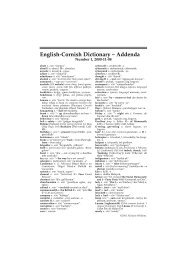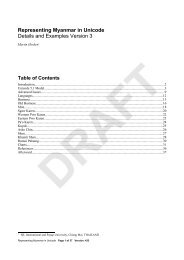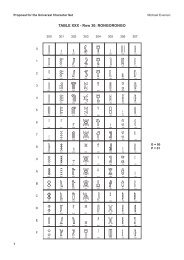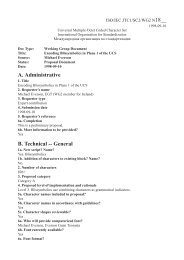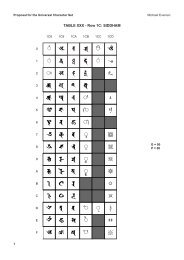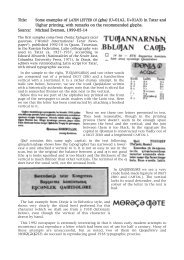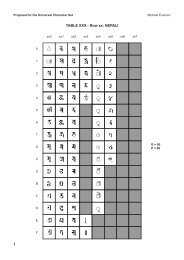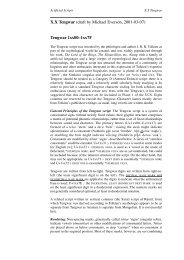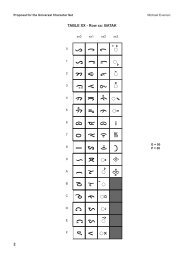Final text for Latin/Greek alphabet TITLE PAGE - Evertype
Final text for Latin/Greek alphabet TITLE PAGE - Evertype
Final text for Latin/Greek alphabet TITLE PAGE - Evertype
You also want an ePaper? Increase the reach of your titles
YUMPU automatically turns print PDFs into web optimized ePapers that Google loves.
© ISO/IEC ISO/IEC 8859-7:2003 (E)<br />
In<strong>for</strong>mation technology —<br />
8-bit single-byte coded graphic character sets –<br />
Part 7: <strong>Latin</strong>/<strong>Greek</strong> <strong>alphabet</strong><br />
1 Scope<br />
This part of ISO/IEC 8859 specifies a set of 188<br />
coded graphic characters identified as <strong>Latin</strong>/<strong>Greek</strong><br />
<strong>alphabet</strong>.<br />
This set of coded graphic characters is intended <strong>for</strong><br />
use in data and <strong>text</strong> processing applications and<br />
also <strong>for</strong> in<strong>for</strong>mation interchange.<br />
The set contains graphic characters used <strong>for</strong><br />
general purpose applications in typical office<br />
environments in at least the following languages:<br />
English, <strong>Greek</strong>, and <strong>Latin</strong>.<br />
This set of coded graphic characters may be<br />
regarded as a version of an 8-bit code according to<br />
ISO/IEC 2022 or ISO/IEC 4873 at level 1.<br />
This part of ISO/IEC 8859 may not be used in<br />
conjunction with any other parts of ISO/IEC 8859.<br />
If coded characters from more than one part are to<br />
be used together, by means of code extension<br />
techniques, the equivalent coded character sets<br />
from ISO/IEC 10367, or their corresponding G1<br />
sets from the ISO International Register of Coded<br />
Character Sets to be Used with Escape<br />
Sequences, should be used instead within a<br />
version of ISO/IEC 4873 at level 2 or level 3.<br />
The coded characters in this set may be used in<br />
conjunction with coded control functions selected<br />
from ISO/IEC 6429. However, control functions are<br />
not used to create composite graphic symbols from<br />
two or more graphic characters (see clause 6).<br />
NOTE – ISO/IEC 8859 is not intended <strong>for</strong> use with<br />
Telematic services defined by ITU-T. If in<strong>for</strong>mation coded<br />
according to ISO/IEC 8859 is to be transferred to such<br />
services, it will have to con<strong>for</strong>m to the requirements of<br />
those services at the access-point.<br />
2 Con<strong>for</strong>mance<br />
2.1 Con<strong>for</strong>mance of in<strong>for</strong>mation interchange<br />
A coded-character-data-element (CC-dataelement)<br />
within coded in<strong>for</strong>mation <strong>for</strong> interchange<br />
is in con<strong>for</strong>mance with this part of ISO/IEC 8859 if<br />
all the coded representations of graphic characters<br />
within that CC-data-element con<strong>for</strong>m to the<br />
requirements of clause 6.<br />
2.2 Con<strong>for</strong>mance of devices<br />
A device is in con<strong>for</strong>mance with this part of<br />
ISO/IEC 8859 if it con<strong>for</strong>ms to the requirements of<br />
2.2.1, and either or both of 2.2.2 and 2.2.3. A claim<br />
of con<strong>for</strong>mance shall identify the document which<br />
contains the description specified in 2.2.1.<br />
2.2.1 Device description<br />
A device that con<strong>for</strong>ms to this part of ISO/IEC 8859<br />
shall be the subject of a description that identifies<br />
the means by which the user may supply<br />
characters to the device, or may recognize them<br />
when they are made available to him, as specified<br />
respectively in 2.2.2 and 2.2.3.<br />
2.2.2 Originating devices<br />
An originating device shall allow its user to supply<br />
any sequence of characters from those specified in<br />
clause 6, and shall be capable of transmitting their<br />
coded representations within a CC-data-element.<br />
2.2.3 Receiving devices<br />
A receiving device shall be capable of receiving and<br />
interpreting any coded representations of characters<br />
that are within a CC-data-element, and that con<strong>for</strong>m<br />
to clause 6, and shall make the corresponding<br />
characters available to its user in such a way that<br />
the user can identify them from among those<br />
specified there, and can distinguish them from each<br />
other.<br />
3 Normative references<br />
The following standards contain provisions which,<br />
through reference in this <strong>text</strong>, constitute provisions<br />
of this part of ISO/IEC 8859. At the time of publication,<br />
the editions indicated were valid. All standards<br />
are subject to revision, and parties to agreements<br />
based on this part of ISO/IEC 8859 are encouraged<br />
to investigate the possibility of applying the most<br />
recent editions of the standards listed below.<br />
Members of IEC and ISO maintain registers of<br />
currently valid International Standards.<br />
1





